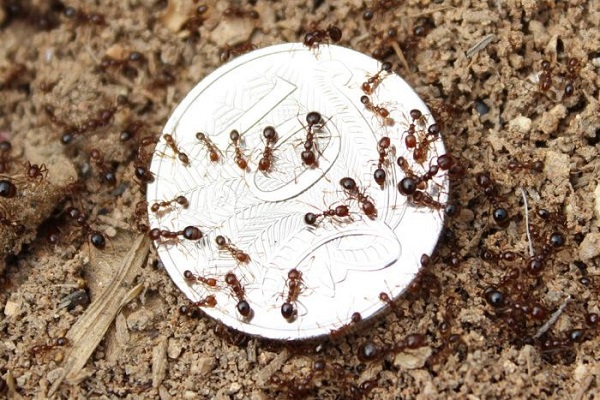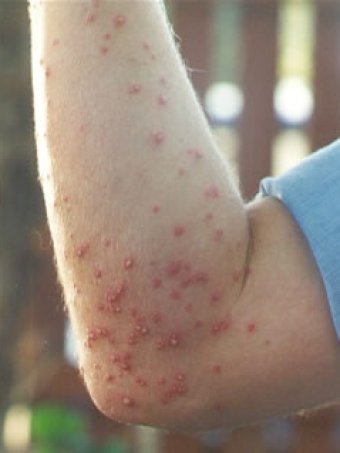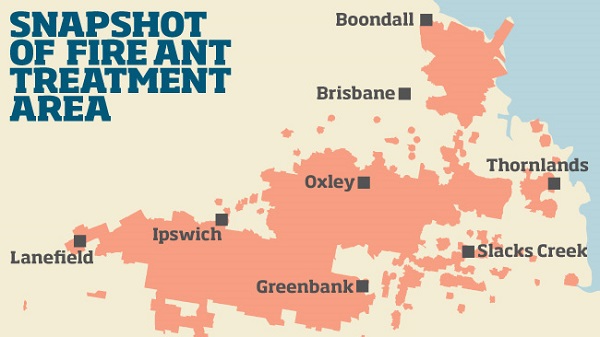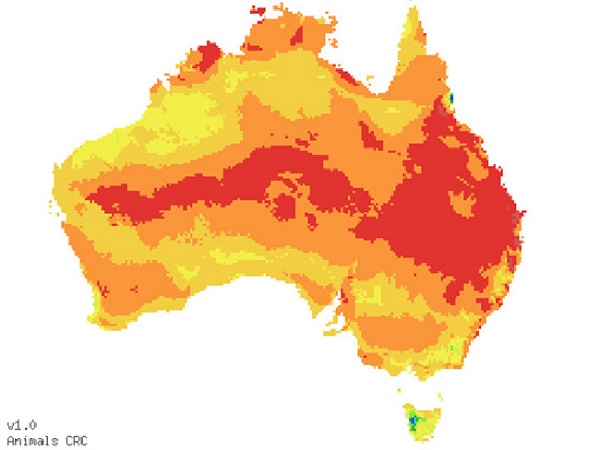1. Fire ants – here to stay?
Fire ants are here, and have the potential to destroy our fauna and alter our way of life. This is what they look like on a 10 cent piece:

They are 2-6mm in size but pack a nasty punch, swarming in their attack, so your arm could look like this, or worse:

In some people they cause anaphylactic shock which can kill. Around 85 people in the US are known to have died, one young teenager in Southern Texas just playing football on a ground found later to have 20 nests. Duty of care? With small animals they go for the eyes and other orifices.
According to a recent Background Briefing investigation, $330 million has been spent in the last 16 years since they were discovered near Brisbane. The containment zone is now almost double the size of the ACT, and a new effort has been launched to spend a further $400 million over the next 10 years.
Authorities say that if nothing had been done fire ants would have spread from Wollongong to Charleville to Mackay. This map may be conservative, but it will give you an idea of where they are now:

More information and a list of suburbs here.
This is where they could end up:

In the US I believe they have stopped at the snow line.
Queens can fly five kilometres to find a new home, nests survive days of being under water, and they can hitch a ride anywhere in a bit of dirt. In June they popped up at Beerwah in the Sunshine Coast hinterland.
Without the $330 million the case would now be hopeless. Eradication is still the aim, but the odds do not look good.
2. Amazon off to a shaky start
Amazon appears to have fluffed its start in Australia by launching just before Christmas, when expectations were high, and then too often failing to deliver within the expected time. Apparently:
- 17 per cent of seller reviews have reported a negative experience with Amazon Australia, mostly due to “late shipments and order cancellations”.
In the US the corresponding number is 4 per cent. So eBay is ‘not yet’ threatened, let alone the established retailers.
eBay has been operating in the Australian market for 18 years, with 40,000 retailers on board, including 80 of the top 100. Managing director Tim MacKinnon says “our most recent Google partnership [to create the eBay Gift Finder] expands our technological capabilities to provide even greater access for consumers.”
3. Trump watch
Tax cuts have come to stay, which will add a mere trillion dollars to the deficit. I’m told 62% of the cuts will go to the 1%, and fully 56% of the people, including much of the Republican base, disagree with them.
Does anyone think companies will use the tax cuts to restore disappearing pension plans?
-
Even as late as the early 1990s, about 60 percent of full-time workers at medium and large companies had pension coverage, according to the government figures. But today, only about 24 percent of workers at midsize and large companies have pension coverage, according to the data, and that number is expected to continue to fall as older workers exit the workforce.
Meanwhile Trump has threatened to cut off aid to countries who voted in favour of a UN motion condemning his decision to recognize Jerusalem as the capital of Israel.
A total of 128 countries backed the resolution, 35 abstained, and nine voted against. We were among the chicken little abstainers.
Here’s where the US spends its aid.
I understand that most Americans think they spend about 25% of GDP on aid. I have not checked, but the truth is said to be nearer one per cent.
I believe foreign aid is governed by Congress, not the presidency, so perhaps sense will prevail.
4. Our contribution to extra-judicial killings
At some time during the festive season we should pause to think about what it means. Leaving that aside, Background Briefing has again been stirring up trouble, trying to engage our conscience by taking a look at what the Pine Gap Joint Defence Facility actually does.
- it seems it’s not our troops that are Australia’s most important contribution to international warfighting, nor our planes or submarines, it’s the massive satellite surveillance base in Central Australia, just 15 minutes’ drive south of Alice Springs, at Pine Gap. It sits between two folds in the West MacDonnell Ranges, and has 800 Australian and US staff, and some 38 radar dishes pointing skywards. Officially it’s labelled the ‘Joint Defence Facility Pine Gap’.
Just helpful information sharing. In fact, an essential part of drone strikes by the US in its program of extra-judicial killings. These are not wars identified by the United Nations. It is whoever the US thinks needs to be culled in its war on terror.
There is an ethical problem with how the targets are selected and the killings implemented. A further problem with the by-kill, the people who happen to be with the target, or if the strike misses its mark.
Obama took a personal interest in this activity, a worry for a Nobel Peace Prize winner. One can’t imagine Trump doing the same, although under him we are told the activity has trebled.
As the technology become more widely available, this can’t end well.
Or we might think about the 45.6 million people in 197 countries caught up in modern slavery.
Last night in iview we watched Jane Hutchins interview Michael Leunig on One Plus One. Leunig says he is an outsider, that we are up to our knecks in sadness, and he is speaking up for the repressed, on behalf of grief, our seeming pact to destroy nature and for the loss of beauty in the world. However, what comes through is gentleness and compassion rather than anger.
Worth a watch.


Fire Ants?
Another glorious addition to Australia’s fantastic record of “Too little, too late” on environmental protection:
Lantana,
Rabbits,
Cane-toads,
Rubber-vine,
Feral cats,
Water-hyacinth,
…. and the dismal list goes on and on.
“Yes, Minister, there may be an isolated minor infestation but we have it completely under control. No need to frighten the voters with any talk about expensive eradication campaigns, is there now?”
There is a French PhD candidate up here and her research is fire ants. I’ll ask her about it early 2018 and see what she has to say about the problem.
We do have them in Cairns region but there are good people working on the problem. Always subject to funding of course…
Geoff, I’ve heard about another ant in the Cairns region – Asian, I think, and I’ll be surprised if you have fire ants.
From near the end of Background Briefing:
They talk about other pests we’ve let go, one of the worst being myrtle rust, which we probably could have eliminated if our mob were not asleep at the wheel. Then:
The core responsibility of the Federal Government, controlling our border, and it sucks at it.
Probably because it’s too busy encroaching on the States responsibilities.
That’s harsh Jumpy. For a long time our bio security has been very good. Eg we still don’t get rabies in Australia. We have many ships and aircraft arriving and our defences against exotics is not too bad. There is relentless pressure on our bio security despite intentional and unintentional attempts to thwart those efforts.
Brian I am certain of fire ants in our region. I’ll get some info ASAP about them.
Meantime , I’ll wish everyone a really Merry Xmas and a HNY. I thank all for their critical comments. Cheers to all
Geoff
Our borders leak like a sieve.
Everything from firearms to tobacco to drugs.
It’s not surprising a few pests get in.
I could easily find thousands of Federal public servants that would better serve Australia in quarantine and border security.
I must note I’m not disparaging any person or persons, just idiotic allocations of them.
And have a Merry Xmas everyone and a year of growth in 2018, what ever types of growth you find important.
Unrealistic Jumpy, our borders may have weak points but we still manage ok. Could we do better? Probably. Re-allocate thousands of civil servants to border control? You should write to Trump and offer him your services
Geoff, the one I’ve heard about in NQ is the yellow crazy ant:
It’s a top 100 pest and the authorities have given up. If you also have the fire ant, be afraid!
Geoff, there are two default problems with biosecurity. One is that trade is increasing, but surveillance is decreasing. A good analogue is the white spot disease in the Logan River prawn industry, where 25 prawn farms have been wiped out:
The second problem is the ideological attachment to competition and the downgrading of risk. I believe the risk of white spot disease was deemed 3% and manageable. Any mathematician will tell you that if you have a 3% risk it is a question of when, not whether.
There’s more here:
With enhanced security samples from three of 115 consignments have tested positive to white spot disease.
Complete rubbish! Perhaps if they inspected all imports, but they don’t.
Geoff Henderson @ 8:50 pm:
We need a wall!
😀
Brian, it seems we as a nation can’t afford a first class health system or a first class education system or first class protection for victims of domestic violence or first class bio-security or even a first class internet. But we can afford tax cuts for the wealthy, fighter planes which, if we ever receive them, will be useless for our needs and overpaid, incompetent, pork barreling politicians.
Such is life.
Sadly, spot on, zoot.
I heard the other day that the tax cuts made by Peter Costello and Swan/Rudd approximate the current deficit.
If they had squirrelled it away in a sovereign wealth fund, we’d now be sitting pretty.
On fire ants and other threats:
I admire the work done by our biosecurity people but they are running on a shoe-string – whilst an immense amount of the Australia’s treasure is blown on obsolescent and ineffective war-toys that no 14-year-old would buy in a blue fit.
We could have the world’s best biosecurity AND a fearsome military capability at half the current price – if only a gaggle of the defence procurement chair-polishers were given the sack, (and no, Jumpey, not redeployed on biosecurity duties either: the sack).
Graham, Mark had an interesting story last night, which was about branding and value adding rather than biosecurity.
Apparently birds nests are a delicacy much-prized by the middle class in China. They are mostly harvested around the ‘golden triangle’, countries that are near or adjacent to China.
However, they are brought down to Indonesia, where they are packaged. At that stage they are worth maybe $7 per unit.
However, they then detour to Melbourne, where experts in biosecurity look at them and give them a ‘green tick’.
At that point they are sent to China valued at about $45 per unit.
Don’t quote the numbers, they are approximate from memory, but the scale of the value added is the point.
One lesson from this story is that economic growth does not necessarily involve a commensurate increase in GHG emissions.
brian – and Mark: Leaving aside the morality of birds’ nest harvesting – that sounds like an innovative and profitable little business. Wonder what else we can bring through Australia’s biosecurity for fun-and-profit?
Brian and Graham
It also reminds me of the economist E.J. Mishan (spelling?) writing in the 1970s about entirely unproductive and even harmful activities which can contribute very solidly to GDP
* for instance, folk are armed to the teeth and randomly, sporadically shooting at strangers…. a fantastic boost to manufacturing and services:
# firearms
# ammunition
# rifle ranges
# body armour, armoured vehicles
# safe refuge rooms in homes and businesses
# coffins
$ hospital wages
$ surgeon and undertaker wages
$ gun shops, retail, wholesale, online shopping, importers, exporters
$ police and court staff wages
$ reality TV: Who Wants to Be a Celebrity Target?
and I’ve only scratched the surface….
***
On a serious note, there must be many economic activities that contribute very little GHG but value-add, therefore make a contribution to the circulation of money; some will involve “intellectual property”, for instance online publishing of
Books
Music
Art work
Cheerio
Ambi, I had a staff member called Marji Hill. decades ago she and her partner Alex Barlow applied for a job that was going at the Australian Institute of Aboriginal Studies. The AIAS was so impressed they hired both.
What those two got up to was astonishing. Alex was a bit older and died a couple of years ago, but Marji is still living in her unit in one of those really tall buildings at the Gold Coast. This year she has published yet another book – First People Then And Now: Introducing Indigenous Australians and with some of her mates has started up a crypto currency, as you do – We Have the Gold.
She does a great line of Christmas cards, birthday cards, wedding invitations and such.
Brian
Thanks for the Marji Hill link. “What they got up to” is a telling phrase.
She and Alex published more than 60 books, says the website.
A painting hangs in Jupiter’s Casino. A book with Al Grassby. What greater accolades could one hope for?
To be a publicist can be remunerative; to be a self-publicist, well the world is your oyster. Somehow Al Grassby of the Ties and Suits; and Sam Dastyari of the TV Profiles and Donations, spring to mind.
Ambi, Alex studied law when he was about 50 and ended up working with one of Australia’s top silks, the name slips my faltering memory.
They actually befriended Al Grasby, took him into their home and looked after him, when he was being pursued by the spooks, who had decided he was a bad person. It’s a story in itself which would make a novel.
Brian
I admire anyone who undertakes degree studies in the fifties or indeed later, and succeeds.
I’m sure there are plenty of colourful stories about the colourful Al Grasby and his colourful compatriots with their extensive horticultural activities around Griffith.
I have sometimes wondered to what extent he took his colourful habits over to Canberra, where the Press were so taken by his colourful ties and extrovert demeanour!!
But I never met Al Grasby.
those days I recall hearing only Saint Gough, Robert James Lee Hawke, Lionel Murphy, Bill Hayden, Jim Cairns, Moss Cass and Frank Crean speaking in public fora at various times in Melbourne.
Do you think she will write the Al Grasby novel soon?
Ambi, we might call in on Marji this year as we are need to go to the Gold Coast some time and stay a couple of nights. I might suggest an Al Grassby novel, which would be worth reading.
You will have seen that Marji wrote Six Australian Battlefields with Al. My understanding is that they actually visited the places were these battles took place. Grassby researched what happened, Marji soaked up the atmosphere and did paintings. I thought all that happened well before 1988, which is given as the publication date.
The pursuit of Al according to Wikipedia lasted 12 years. This item by Mark Colvin also relates to Mackay family protests over a statue of Grassby being erected.
I saw Marji and Alex from time to time when they visited Brisbane. They were living in Canberra at the time, and I know they took Grassby into their home and that he had not a cent to bless himself with. They helped raise money to fight the legal case.
I recall them saying that if they wanted to talk they used to take a walk in the park.
Whatever the truth of it is, I think without Marji and Alex Grassby would have been stuffed.
Interesting story, Brian.
I hope she writes a memoir about it. Perhaps it could be published after she has gone to the great Library in the Sky?
The Blessed Ambi